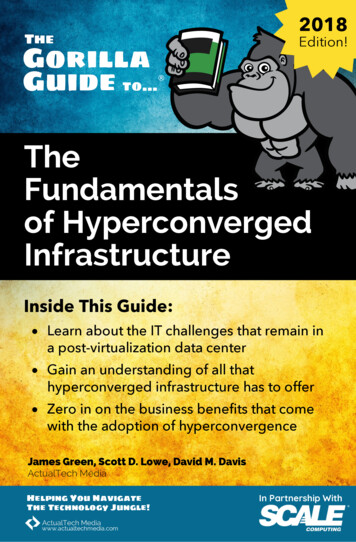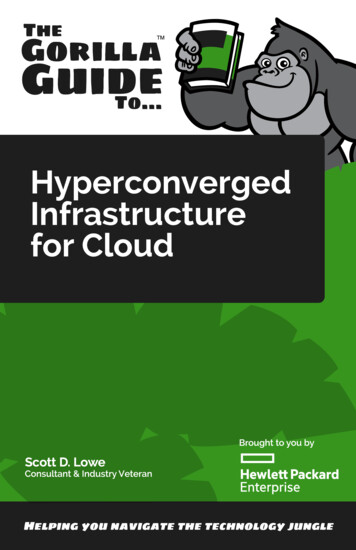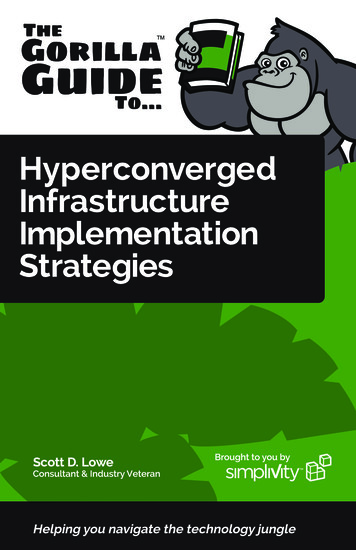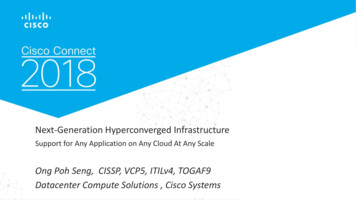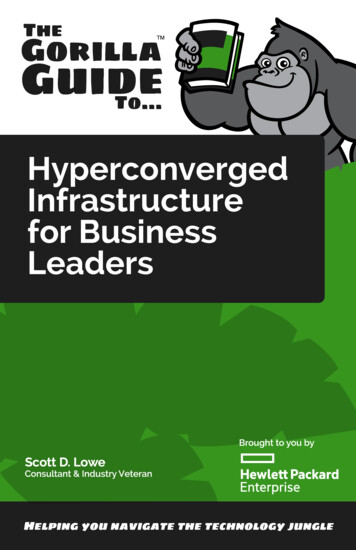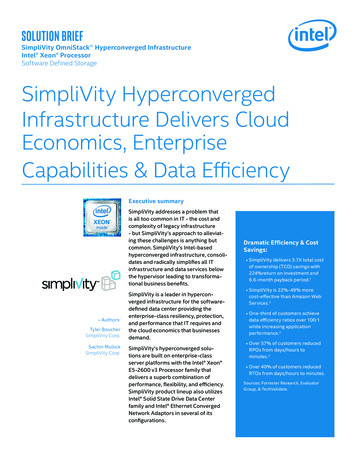
Transcription
These materials are 2014 John Wiley & Sons, Inc. Any dissemination, distribution, or unauthorized use is strictly prohibited.
HyperconvergedInfrastructureSimpliVity Special Editionby Scott D. LoweThese materials are 2014 John Wiley & Sons, Inc. Any dissemination, distribution, or unauthorized use is strictly prohibited.
Hyperconverged Infrastructure For Dummies , SimpliVity Special EditionPublished byJohn Wiley & Sons, Inc.111 River St.Hoboken, NJ 07030-5774www.wiley.comCopyright 2014 by John Wiley & Sons, Inc., Hoboken, New JerseyNo part of this publication may be reproduced, stored in a retrieval system or transmitted in any formor by any means, electronic, mechanical, photocopying, recording, scanning or otherwise, except aspermitted under Sections 107 or 108 of the 1976 United States Copyright Act, without the prior writtenpermission of the Publisher. Requests to the Publisher for permission should be addressed to thePermissions Department, John Wiley & Sons, Inc., 111 River Street, Hoboken, NJ 07030, (201) 748-6011,fax (201) 748-6008, or online at http://www.wiley.com/go/permissions.Trademarks: Wiley, For Dummies, the Dummies Man logo, The Dummies Way, Dummies.com, MakingEverything Easier, and related trade dress are trademarks or registered trademarks of John Wiley &Sons, Inc. and/or its affiliates in the United States and other countries, and may not be used withoutwritten permission. SimpliVity and the SimpliVity logo are trademarks of SimpliVity Corporation. Allother trademarks are the property of their respective owners. John Wiley & Sons, Inc., is not associated with any product or vendor mentioned in this book.LIMIT OF LIABILITY/DISCLAIMER OF WARRANTY: THE PUBLISHER AND THE AUTHOR MAKE NOREPRESENTATIONS OR WARRANTIES WITH RESPECT TO THE ACCURACY OR COMPLETENESSOF THE CONTENTS OF THIS WORK AND SPECIFICALLY DISCLAIM ALL WARRANTIES, INCLUDINGWITHOUT LIMITATION WARRANTIES OF FITNESS FOR A PARTICULAR PURPOSE. NO WARRANTYMAY BE CREATED OR EXTENDED BY SALES OR PROMOTIONAL MATERIALS. THE ADVICE ANDSTRATEGIES CONTAINED HEREIN MAY NOT BE SUITABLE FOR EVERY SITUATION. THIS WORK ISSOLD WITH THE UNDERSTANDING THAT THE PUBLISHER IS NOT ENGAGED IN RENDERINGLEGAL, ACCOUNTING, OR OTHER PROFESSIONAL SERVICES. IF PROFESSIONAL ASSISTANCE ISREQUIRED, THE SERVICES OF A COMPETENT PROFESSIONAL PERSON SHOULD BE SOUGHT.NEITHER THE PUBLISHER NOR THE AUTHOR SHALL BE LIABLE FOR DAMAGES ARISING HEREFROM. THE FACT THAT AN ORGANIZATION OR WEBSITE IS REFERRED TO IN THIS WORK AS ACITATION AND/OR A POTENTIAL SOURCE OF FURTHER INFORMATION DOES NOT MEAN THATTHE AUTHOR OR THE PUBLISHER ENDORSES THE INFORMATION THE ORGANIZATION ORWEBSITE MAY PROVIDE OR RECOMMENDATIONS IT MAY MAKE. FURTHER, READERS SHOULDBE AWARE THAT INTERNET WEBSITES LISTED IN THIS WORK MAY HAVE CHANGED OR DISAPPEARED BETWEEN WHEN THIS WORK WAS WRITTEN AND WHEN IT IS READ.For general information on our other products and services, or how to create a custom For Dummiesbook for your business or organization, please contact our Business Development Department in theU.S. at 877-409-4177, contact info@dummies.biz, or visit www.wiley.com/go/custompub. Forinformation about licensing the For Dummies brand for products or services, contact BrandedRights&Licenses@Wiley.com.ISBN 978-1-119-01394-5 (pbk); ISBN 978-1-119-01395-2 (ebk)Manufactured in the United States of America10 9 8 7 6 5 4 3 2 1Publisher’s AcknowledgmentsSome of the people who helped bring this book to market include the following:Development Editor: Kathy SimpsonSenior Project Editor: Zoë WykesAcquisitions Editor: Katie MohrEditorial Manager: Rev MengleBusiness Development Representative: Sue BlessingProject Coordinator: Melissa CossellSimpliVity contributors: Jesse St. Laurent, Lauren WhitehouseThese materials are 2014 John Wiley & Sons, Inc. Any dissemination, distribution, or unauthorized use is strictly prohibited.
Table of ContentsIntroduction . . . . . . . . . . . . . . . . . . . . . . . . . . . . . . . . . . . . . . 1About This Book. 1Foolish Assumptions. 2Icons Used in This Book. 2Beyond the Book. 2Where to Go from Here. 2Chapter 1: Hyperconverged Infrastructure Basics . . . . . 3Defining Hyperconvergence. 3Hyperconvergence Constructs. 4Chapter 2: Virtualization Challenges. . . . . . . . . . . . . . . . . 5Infrastructure Innovation. 5Underused Resources. 6Multiple Management Interfaces. 7Deployment Difficulty and Delays. 8Storage. 10IO blender. 10VDI boot storm. 12Mitigation. 12Multiple Touchpoints. 13Policy Misalignment. 16Chapter 3: Welcome to the SDDC. . . . . . . . . . . . . . . . . . . 17Virtualization. 17Automation. 18IT as a Service. 19Chapter 4: What Businesses Want from IT. . . . . . . . . . . 21Increased Efficiency. 22Using time better. 22Matching skills to tasks. 22Managing resources wisely. 23Meeting budgets. 24Reduced Risk. 24Improved Agility. 25These materials are 2014 John Wiley & Sons, Inc. Any dissemination, distribution, or unauthorized use is strictly prohibited.
ivHyperconverged Infrastructure For DummiesChapter 5: How the Cloud Is Changing IT. . . . . . . . . . . . 27Scaling and Sharing Resources. 27Software-centric design. 28Economies of scale. 28Resource flexibility. 29Enabling Automation. 29Abstracting policy from infrastructure. 30Taking a VM-centric approach. 30Understanding Cloud Economics. 31Chapter 6: Understanding Converged Infrastructure . . . 33The Evolution of Convergence. 34Integrated systems. 34Converged infrastructure. 34Hyperconverged infrastructure. 35Convergence Characteristics. 36Chapter 7: Ten Things HyperconvergenceCan Do for You. . . . . . . . . . . . . . . . . . . . . . . . . . . . . . . . . 37Software Focus. 38Use of Commodity x86 Hardware. 38Centralized Systems and Management. 38Enhanced Agility. 39Scalability and Efficiency. 39Low Cost. 40Easy Automation. 40Focus on VMs. 40Shared Resources. 41Data Protection. 42Chapter 8: Seven Ways to ApplyHyperconvergence. . . . . . . . . . . . . . . . . . . . . . . . . . . . . 43These materials are 2014 John Wiley & Sons, Inc. Any dissemination, distribution, or unauthorized use is strictly prohibited.
IntroductionOver the past few years, a lot has happened to IT and tothe technology industry. First and foremost, businessleaders continue to demand more from their IT functions,including better and faster service, with seemingly endlessexpectations for increased efficiency.In addition, several industry trends have had significant effectson enterprise IT: The proliferation of purpose-built devices The rise of the software-defined data center (SDDC) The emergence of cloud computing — or at least cloudprinciples and economics — as a key driver of enterprise IT The emergence of converged infrastructure The use of flash storage in certain enterprise applicationsAt the center of all these trends lies hyperconvergence, whichis the third generation of a series of converged opportunitiesthat have hit the market. Hyperconverged infrastructure (alsoknown as hyperconvergence) is a data center architecture thatembraces cloud principles and economics. Based on software,hyperconverged infrastructure consolidates server compute,storage, network switch, hypervisor, data protection, dataefficiency, global management, and other enterprise functionality on commodity x86 building blocks to simplify IT, increaseefficiency, enable seamless scalability, improve agility, andreduce costs.About This BookThe hyperconvergence story has many chapters. In this smallbook, I discuss the trends that are leading modern IT to hyperconverged infrastructure. I also discuss both the technicaland business benefits that come from implementing a datacenter based on hyperconverged infrastructure.These materials are 2014 John Wiley & Sons, Inc. Any dissemination, distribution, or unauthorized use is strictly prohibited.
2Hyperconverged Infrastructure For DummiesFoolish AssumptionsIn this book, I assume that you know a little something aboutvirtualization and cloud computing trends and models. As such,this book is written primarily for IT executives and managerssuch as Chief Information Officers (CIOs), Chief TechnologyOfficers (CTOs), IT directors, and technical managers.Icons Used in This BookThroughout the book, you’ll find several icons in the margins.Here’s a rundown of what these icons mean.Anything that has a Remember icon is well worth committingto memory.The Technical Stuff icon indicates extra-credit reading. Youcan skip it if you like (but I hope you won’t).The Tip icon points out helpful information.The Warning icon alerts you to risks of various kinds.Beyond the BookThere’s only so much I can cover in such little space. If you’reeager to learn more about hyperconverged infrastructure afterreading this book, visit www.hyperconverged.org.Where to Go from HereLike all For Dummies books, this book is designed to be readin any order you choose. Start with the chapter that interestsyou most, or read straight through. Hey, it’s your book, so it’stotally up to you.These materials are 2014 John Wiley & Sons, Inc. Any dissemination, distribution, or unauthorized use is strictly prohibited.
Chapter 1HyperconvergedInfrastructure BasicsIn This Chapter Understanding what hyperconvergence is Discussing the many forms of hyperconvergenceCorporate technology undergoes a massive shift every so oftenas new models emerge to meet changing business needs.This chapter is about hyperconverged infrastructure, which isthe culmination and conglomeration of a number of trends, allof which provide specific value to the modern enterprise.Defining HyperconvergenceSo, what is hyperconvergence? At the highest level, hyperconvergence is a way to enable cloudlike economics and scalewithout compromising the performance, reliability, and availability you expect in your own data center. Hyperconvergedinfrastructure provides significant benefits: Data efficiency: Hyperconverged infrastructure reducesstorage, bandwidth, and IOPS requirements. Elasticity: Hyperconvergence makes it easy to scale out/inresources as required by business demands. VM-centricity: A focus on the virtual machine (VM) orworkload as the cornerstone of enterprise IT, with allsupporting constructs revolving around individual VMs. Data protection: Ensuring that data can be restored inthe event of loss or corruption is a key IT requirement,made far easier by hyperconverged infrastructure.These materials are 2014 John Wiley & Sons, Inc. Any dissemination, distribution, or unauthorized use is strictly prohibited.
4Hyperconverged Infrastructure For Dummies VM mobility: Hyperconvergence enables greaterapplication/workload mobility. High availability: Hyperconvergence enables higherlevels of availability than possible in legacy systems. Cost efficiency: Hyperconverged infrastructure brings toIT a sustainable step-based economic model that eliminates waste.Hyperconvergence is the ultimate in an overall trend of convergence that has hit the market in recent years. Convergence isintended to bring simplicity to increasingly complex data centers.Hyperconvergence ConstructsConvergence comes in many forms. At its most basic, convergence simply brings together existing individual storage,compute, and network switching products into pre-tested, prevalidated solutions sold as a single solution. However, this levelof convergence only simplifies the purchase and upgrade cycle.It fails to address ongoing operational challenges that have beenintroduced with the advent of virtualization. There are still LUNsto create, WAN optimizers to acquire and configure, and thirdparty backup and replication products to purchase and maintain.Hyperconvergence is a ground-up rethinking of all theservices that comprise the data center. With a focus on thevirtual machine or workload, all the elements of the hyperconverged infrastructure support the virtual machine as thebasic construct of the data center.The results are significant and include lower CAPEX as a resultof lower upfront prices for infrastructure, lower OPEX throughreductions in operational expenses and personnel, and fastertime-to-value for new business needs. On the technical side,newly emerging infrastructure generalists — people withbroad knowledge of infrastructure and business needs — caneasily support hyperconverged infrastructure. No longer doorganizations need to maintain separate islands of resourceengineers to manage each aspect of the data center.To fully understand hyperconvergence, it’s important to understand the trends that have led the industry to this point. Theseinclude post-virtualization headaches, the rise of the softwaredefined data center, and cloud computing.These materials are 2014 John Wiley & Sons, Inc. Any dissemination, distribution, or unauthorized use is strictly prohibited.
Chapter 2Vir tualization ChallengesIn This Chapter Keeping up with innovation Using resources efficiently Looking at management interfaces Discussing touchpoints Setting effective policiesFact: Virtualization fundamentally and permanently changedIT and the data center. Today, most services are runninginside virtual environments, and IT often takes a “virtualizedfirst” approach to new application and service deployment.That is, administrators consider the virtual environment forrunning new applications rather than just building a new physical environment.Although virtualization offers significant benefits, it also introduces challenges that IT must overcome to help propel thebusiness forward. This chapter describes those challenges.Infrastructure InnovationEvery time a startup company releases a great new product,enterprises scramble to implement that solution. The proliferation of purpose-built devices has created unnecessarycomplexity — and the result has been data center chaos.Innovation is great, and we all want it to continue, but eventually, data centers have so much stuff that they become unmanageable. It’s time to clean out the closet, so to speak.These materials are 2014 John Wiley & Sons, Inc. Any dissemination, distribution, or unauthorized use is strictly prohibited.
6Hyperconverged Infrastructure For DummiesOver the past decade, IT departments have focused on solvingthe storage capacity problem, deploying all kinds of technologies to tame the capacity beast, such as WAN optimizationand backup deduplication appliances. As a result, data efficiency technologies have become standard features of manydifferent products.But what happens when you put these products together inthe data center? You end up constantly deduplicating andhydrating data as it moves between various devices. Storagededuplicates data; then you read the data to back it up, whereit requires hydration (to return it to a state that the backupapplication understands) and often re-deduplicating it somewhere in the backup data path. The CPU cost to reprocess thesame data is enormous, not to mention the bandwidth cost ofall that hydrated data.Deduplication is the process in which data is examined forcommon blocks. When identified, these common blocks arereplaced with a tiny little pointer to the unique copy of thedata already stored on disk — which takes up significantlyless capacity when written to storage. Deduplication has atremendous savings on storage capacity and, importantly,on input/output operations per second (IOPS) since fewerwrites occur to disk. Hydration is reversing the deduplication process, such as when moving the data to a new systemthat doesn’t support deduplicated data.I discuss this challenge in more depth later in this chapter.Underused ResourcesVirtualization helped organizations consolidate many of theirservers to run on a common platform: the hypervisor software layer. This move has helped IT departments make muchbetter use of their server resources. Before virtualization, itwas common for server utilization to average just 15 percent.Virtualization has pushed that average much higher. As aresult, organizations now enjoy a much better return on theirserver investments. Moreover, they usually don’t need to buyas many physical servers as they did in the past.These materials are 2014 John Wiley & Sons, Inc. Any dissemination, distribution, or unauthorized use is strictly prohibited.
Chapter 2: Virtualization Challenges7Virtualization has changed the game when it comes to serverresources. Unfortunately, IT departments often need to maintain separate groups of people to manage separate hardwareresources. One group manages storage, for example; anothergroup manages the server side; a third group handles networking. When an issue arises, it’s not uncommon to see a lotof finger-pointing.Further, emerging workloads are creating resource challengesthat push IT departments to develop infrastructure environments on a per-service basis. Virtual desktop infrastructure(VDI) environments, for example, have vastly different resourceusage patterns from server virtualization projects. To meetuser expectations with VDI, IT professionals often implementcompletely separate environments, from servers on downto storage.Aren’t resource islands the very problems that virtualizationis meant to solve? These islands are among the biggest culprits of underutilization. Virtualization is supposed to result ina single resource pool from which resources are carved out tomeet application needs, thereby maximizing the use of thoseresources.Multiple Management InterfacesStorage devices. Optimizers. Hypervisors. Load balancers.What do they have in common? Each of these disparate components features its own management interface. If you usemultiple components, each with separate management consoles (and policy engines) rather than a single, centralized,easy-to-use administrative system, you may experience thefollowing challenges: Vendors blaming each other when something goes wrong. The inability to scale your data center environment easilyand linearly. Greater complexity due to policies and managementbeing tied to IT components versus workloads.These materials are 2014 John Wiley & Sons, Inc. Any dissemination, distribution, or unauthorized use is strictly prohibited.
8Hyperconverged Infrastructure For DummiesDeployment Difficultyand DelaysResource challenges represent the number-one reason whyorganizations continue to have problems deploying new applications and services. A close second is administrative overhead. Allow me to explain.Converting to flat ITThe legacy data center is very delicate in many ways. Any change atany level has the potential to disruptthe overall structure. With lessonsand tactics learned from the bigcloud vendors, hyperconvergencevendors are replacing tiered andresource-siloed data centers with amuch flatter IT structure. As practically all of the formerly separateddata center hardware gets foldedinto the hyperconverged environment, the IT department needs toshift its focus, changing its resourcing structures and skill sets. Ratherthan having staff with deep subjectmatter knowledge in each resourcearea, hyperconvergence can giverise to infrastructure generalists.have enough broad knowledge tomeet business needs and to managethe entire environment through asingle administrative interface. Inmany ways, these people are farmore application-focused than theirisland-based predecessors were.They just need to know how to applyinfrastructure resources to meetindividual application needs.Emerging infrastructure generalists don’t have deep knowledge ofindividual resources, but they havebroad knowledge of all resourceareas. They don’t need to havedeep knowledge. In a hyperconverged world, the most complexstuff is handled under the hood.Infrastructure generalists need to A flat data center managed byan infrastructure engineeringgroup provides improved economies of scale compared with oldresource islands.This development offers several bitsof really good news for IT departments that have struggled to align IToperations with business needs: This new structure paves theway to eliminating the inefficientresource management islandsthat have emerged in IT. Infrastructure generalists are farcloser to applications than specialists of old were.These materials are 2014 John Wiley & Sons, Inc. Any dissemination, distribution, or unauthorized use is strictly prohibited.
Chapter 2: Virtualization Challenges9Flash arrays as quick fixesAs flash-based (and really fast) storage has emerged at relatively affordable prices, new arms of the storagemarket have sprung up. One sucharm provides storage arrays basedsolely on flash storage.a far more balanced and reasonable approach to meeting workloadneeds. In addition, the cost per gigabyte of flash storage is pretty expensive compared with other storageoptions. That said, for applicationsthat need to achieve hundreds ofAlthough vendors in this all-flashthousands or even millions of IOPSspace offer compelling products,in a tiny amount of rack space, allmany of these products are quickflash arrays can’t be beat. For everyfixes designed to solve single- thing else, consider more balancedapplication problems — think VDIstorage options. Remember, a flashand Big Data analytics. For the vastarray really is a higher-performingmajority of enterprise workloads,storage array. It doesn’t addressthough, all-flash arrays are the verythe resource islands, infrastructuredefinition of throwing hardware at amanagement, interoperability chalperformance problem. Storage solulenges, or scalability issues of thetions based on a combination of flashmodern data center.storage and spinning disks provideMultiple challenges exist on the resource front, including thefollowing: IO blender: The consolidation of virtual machines (VMs)contributes to a random IO workload — each with itsown pattern for reading/writing data to storage. I discussthe IO blender in detail later in this chapter. Capacity: Another challenge is ensuring adequate capacity as the organization grows. With resources divvied upand islands of resources strewn about the data center,managing ongoing capacity so that there’s enough to goaround becomes increasingly difficult. Overhead: Even if you have enough resources to deploya new application (see the preceding bullet), the administrative overhead involved in the process presents its ownchallenges: A new logical unit number (LUN) must be provisioned to support the new application. If tiers ofThese materials are 2014 John Wiley & Sons, Inc. Any dissemination, distribution, or unauthorized use is strictly prohibited.
10Hyperconverged Infrastructure For Dummiesstorage are involved, this process could requiremultiple steps. One or more new VMs must be provisioned. Networking for those new VMs has to be configured. Load balancers and wide-area network (WAN) optimization devices need to be managed to supportthe new VMs. Data protection mechanisms must be implementedfor the new services.Whew! That’s a lot to do. All of it is time-consuming, and all ofit involves different teams of people in IT. Good luck!StorageVirtualization is heavily dependent on storage, but thisresource has wreaked havoc in companies that are workinghard to achieve 100 percent virtualized status. Here’s why.Consider your old-school, physical server-based workloads.When you built those application environments, you carefullytailored each server to meet the unique requirements for eachindividual application. Database servers were awarded twosets of disks — one for database files and one for log files —with different redundant array of independent disks (RAID)structures. File servers got RAID 5 to maximize capacity, whilestill providing data protection.Now consider your virtualized environment. You’ve taken allthese carefully constructed application environments andchucked them into a single shared-storage environment. Eachapplication still has specific storage needs, but you’ve basically asked the storage to sort out everything for you, and ithasn’t always done a good job.IO blenderIn the old days, storage systems were optimized around LUNmanagement. LUNs were replicated from a controller in onestorage array to a LUN attached to a controller in a secondarray. The storage systems took snapshots of LUNs, and LUNscould be moved from one host to another host.These materials are 2014 John Wiley & Sons, Inc. Any dissemination, distribution, or unauthorized use is strictly prohibited.
Chapter 2: Virtualization Challenges11Today, servers have been replaced by VMs, and many VMs arerunning on a single host and many hosts are using a single LUNto store VMs. This means that the storage system has dozens(or hundreds) of logical servers (VMs) all stored in the sameLUN. A single application or host or VM can no longer be managed from the storage system perspective.A VM-centric platform cuts through this IO blender — a termthat’s been coined to describe environments in which mixedIO patterns are vying for limited storage resources — andallows you to optimize individual VMs. Policies can be appliedto individual VMs. Performance can be optimized for individual VMs. Backups can be managed per VM, and replicationis configured per VM.Do you see a pattern emerging here?When all your applications attempt to work together on thesame LUN, the IO blender is created. Here are some ways thatcommon services contribute to the IO blender: Databases: Databases feature random IO patterns. Thesystem has to jump all over the disk to find what you’relooking for. Database log files: Log files are sequential in nature.Usually, you just write to log files — again, sequentially. Random file storage: File servers are very random whenit comes to IO. You never know when a user will besaving a new file or opening an old one. Enterprise-level applications: Applications such asMicrosoft Exchange and SharePoint are sensitive in termsof storage configuration, and each application oftenincludes a mix of random and sequential IO. VDI: VDI is one of the primary disruptors in the storagemarket. VDI storage needs are varied. Sometimes, youneed only 10 to 20 IOPS per user. At other times, such aswhen you’re handling boot storms and login storms, IOPSneeds can skyrocket.What the industry has done over the years is combine allthese varied workloads. In other words, their very efforts toconsolidate environments have created a storage monster.These materials are 2014 John Wiley & Sons, Inc. Any dissemination, distribution, or unauthorized use is strictly prohibited.
12Hyperconverged Infrastructure For DummiesMany storage-area network (SAN)-based storage environments suffer big-time problems due to this IO blender: Continued consolidation of VMs contributes to randomIO workloads, each with its own pattern for reading andwriting data to underlying storage. Highly random IO streams adversely affect ove
BE AWARE THAT INTERNET WEBSITES LISTED IN THIS WORK MAY HAVE CHANGED OR DISAP-PEARED BETWEEN WHEN THIS WORK WAS WRITTEN AND WHEN IT IS READ. For general information on our other products and services, or how to create a custom For Dummies book for your business or organizat
